December 4, 2015
Air Date: December 4, 2015
FULL SHOW
SEGMENTS
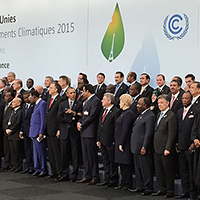
Climate Summit Boosted By Optimism at the Start
View the page for this story
As the UN climate talks opened in Paris, negotiators were optimistic about reaching an agreement by the end of the December 11th deadline, but questions remain about how strong and ambitious the proposed limits and measures will be. The Prince of Wales, President Obama, and President Christopher Loeak of the Marshall Islands were among the many dignitaries who stressed the urgency of acting swiftly to limit greenhouse gas emissions and adapt to climate change. Host Steve Curwood reports. (05:15)

Paris Progress So Far
View the page for this story
PARIS CLIMATE TALKS – PROGRESS SO FAR: The COP21 in Paris could well be the most important climate conference so far, as negotiators from around the world try to hammer out a deal to forestall climate chaos. Host Steve Curwood and veteran observer Alden Meyer from the Union of Concerned Scientists discuss how the talks are going one week in, and what challenges and sticking points remain as we head into week two. (07:50)
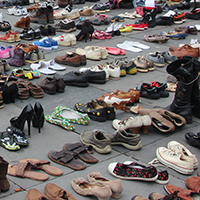
Climate Activists Defy Paris Protest Ban
/ Emmett FitzGeraldView the page for this story
The French government cancelled all major protests in the wake of last months’ attacks in Paris, but that hasn’t stopped the climate justice movement from making itself heard and its presence felt. Living on Earth’s Emmett FitzGerald reports from the streets of Paris. (08:15)
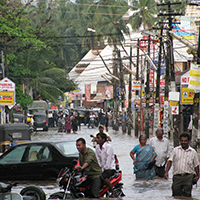
How Will the World Address Loss and Damage From Climate Disruption?
View the page for this story
Some effects of global warming are becoming more intense, such as more intense storms, droughts, land-loss due to rising seas, and displacement of communities. Host Steve Curwood speaks with Erica Bower, lead loss and damage campaigner with the youth group SustainUs, about emerging discussions at COP21 concerning those most affected by climate change and how to address their needs. (05:05)
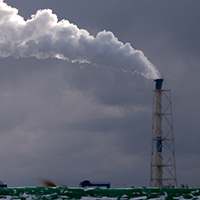
2400 Coal-Fired Power Plants Planned Despite Climate-Friendly Pledges
/ Helen PalmerView the page for this story
Coal-fired power plants have provided cheap energy for over a hundred years, and despite coal-burning’s high emissions, about 2,400 are planned globally. A new study calculates that emissions from global energy generation must reach zero before the middle of the century to keep climate change below a two-degree Celsius temperature rise. Niklas Hohne of the New Climate Institute discusses the study with Living on Earth’s Helen Palmer and explains why building these plants is inconsistent with emissions control commitments countries have given. (05:55)
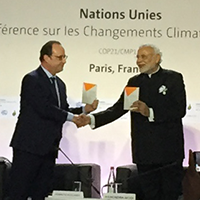
India's Solar Initiative and the Challenge of Climate-Safe Development
View the page for this story
Indian President Narendra Modi announced a bold new $1 trillion solar initiative at the COP21. We hear the details and host Steve Curwood learns from two East African Heads of State what role solar can play in their countries’ development. Finally he discusses with Chandra Bhushan of India’s Center for Science and the Environment the challenges India faces and its role at these climate talks. (14:45)
Show Credits and Funders
Show Transcript
HOST: Steve Curwood
GUESTS: Alden Meyer, Erica Bower, Niklas Höhne, Uhuru Kenyatta, Hailemariam Desalegn, Chandras Bhushan
REPORTERS: Emmett FitzGerald, Helen Palmer
[THEME]
CURWOOD: From Public Radio International, this is Living on Earth.
[THEME]
CURWOOD: I'm Steve Curwood. President Obama and other world leaders gather at the climate summit in Paris.
OBAMA: Nearly 200 nations have assembled here this week, a declaration that for all the challenges we face, the growing threat of climate change could define the contours of this century more dramatically than any other. And what should give us hope that this is a turning point, that this is the moment we finally determined we would save our planet, is the fact that our nations share a sense of urgency about this challenge and a growing realization that it is within our power to do something about it.
CURWOOD: Efforts to forge a treaty and more this week, on Living on Earth. Stick around.
[NEWSBREAK MUSIC: Boards of Canada “Zoetrope” from “In a Beautiful Place Out in the Country” (Warp Records 2000)]
ANNOUNCER: Support for Living on Earth comes from United Technologies – innovating to make the world a better, more sustainable, place to live.
Climate Summit Boosted By Optimism at the Start
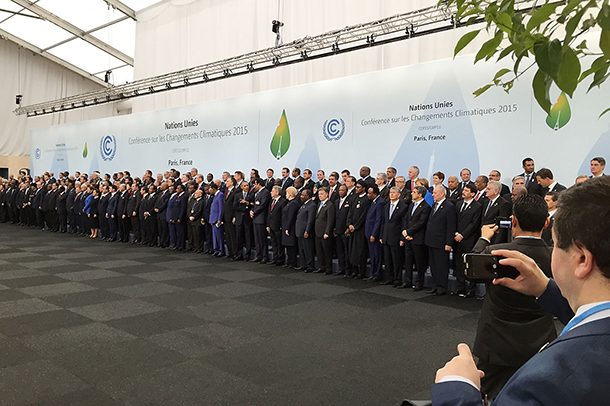
World leaders, heads of state and dignitaries gathered in Paris, France to negotiate strategies for mitigating and adapting to climate change. (Photo: UNclimatechange, Flickr CC BY 2.0)
[THEME]
CURWOOD: From Paris, France and PRI, this is Living on Earth. I’m Steve Curwood. As the climate summit wraps up its first week of negotiations, one thing is clear. Almost everyone here says there will be a new deal to succeed the Kyoto Protocol in 2020 with new limits on greenhouse gas emissions and new measures to adapt to the coming changes from climate disruption.
But huge questions remain about how strong and ambitious those limits and measures will be as negotiators try to wrap things up by a December 11th deadline. The mood here in Paris is in sharp contrast to earlier summits that have mostly stalled since the creation of the Kyoto Protocol in 1997. And the clearest signal that this time is different came when an unprecedented number of about 150 heads of state and government arrived on November 30th, at the beginning of this 21st conference of the parties to the UN Framework Convention on Climate Change, otherwise known as COP21. Urgency was in the air as Prince Charles of Britain opened a day of speeches from all the leaders present and in many respects he spoke for all.
PRINCE CHARLES: Ladies and Gentlemen, rarely in human history have so many people around the world placed their trust in so few. Your deliberations over the next two weeks will decide the fate, not only of those alive today, but also of generations yet unborn. So I can only urge you to think of your grandchildren as I think of mine, and of those billions of people without a voice, those for whom hope is the rarest of sensations, those for whom a secure life is a distant prospect.
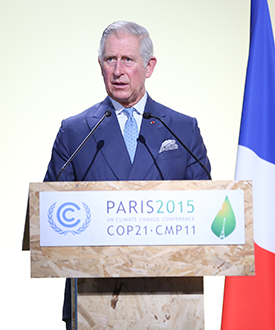
Prince Charles speaking at COP21 (Photo: UNclimatechange, Flickr CC BY 2.0)
In damaging our climate we become the architects of our own destruction. While the planet can survive the scorching of the earth and the rising of the waters, the human race cannot. The absurd thing is that we know exactly what needs to be done; we know we cannot adapt sufficiently to go on as we are, nor can we build ourselves a new atmosphere. To avoid catastrophe we must restrict climate change to less than two degrees, which requires a dramatic reduction in carbon emissions.
CURWOOD: That same sense of weight and urgency was echoed as the other leaders followed Prince Charles. US President Barack Obama pointed to the burning tundra, melting glaciers and villages slipping into the seas that he observed in Alaska as reasons why he believes countries will act together now to make these negotiations a success.
OBAMA: Nearly 200 nations have assembled here this week, a declaration that for all the challenges we face, the growing threat of climate change could define the contours of this century more dramatically than any other. And what should give us hope, that this is a turning point, that this is the moment we finally determined we would save our planet, is the fact that our nations share a sense of urgency about this challenge and a growing realization that it is within our power to do something about it.
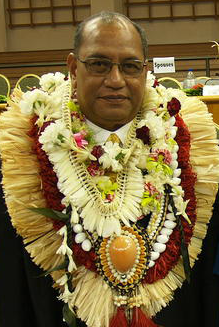
Marshall Islands President Christopher Loeak gave a moving speech at COP21. (Photo: Government of Marshall Islands, Wikimedia Commons CC)
CURWOOD: Russian President Vladimir Putin called for a comprehensive, effective and equitable agreement. Chinese President Xi Jinping spoke of the need for a comprehensive, balanced, ambitious and binding agreement. The official host of COP21 is French President Francois Hollande, and as he thanked the world for support in the wake of the recent murderous attacks on the streets of Paris, he also noted that this crucial summit is about the future of life itself. The children of world need to be free from more than terrorism, Hollande said, they must also be free to live on an unspoiled planet. And then President Christopher Loeak of the Marshall Islands brought the global challenge of climate disruption down to the very personal.
LOEAK: I address you today not only as a president, but as a father, as a grandfather, as a custodian of my culture, and as a representative of a nation that lies just two meters above sea level and risks being submerged by the rising waves. Everything I know and everyone I love is in the hands of all of us gathered here today. The climate we know over many centuries has changed dramatically before our very eyes. We are already limping from climate disaster to climate disaster, and we know there is worse to come. For us, COP21 must be a turning point in history and one that give us hope.
Related links:
- Citing Urgency, World Leaders Converge on France for Climate Talks
- The Marshall Islands Are Disappearing
- Fanfare Over, Paris Climate Talks Shift to Back Rooms and Brackets
- Watch videos from COP21
- COP21: Hollande full speech to world leaders at conference opening
- PM Modi's speech at the inauguration of India Pavilion at COP21 Summit'15 in Paris, France
- COP21: Putin's full speech on Russia climate change reform
- COP21: Putin, Obama, other world leaders talk climate change
- Watch China's president Xi Jinping's address at Paris Climate Conference COP21
- About COP21
- Photos from the UNFCCC COP21
Paris Progress So Far
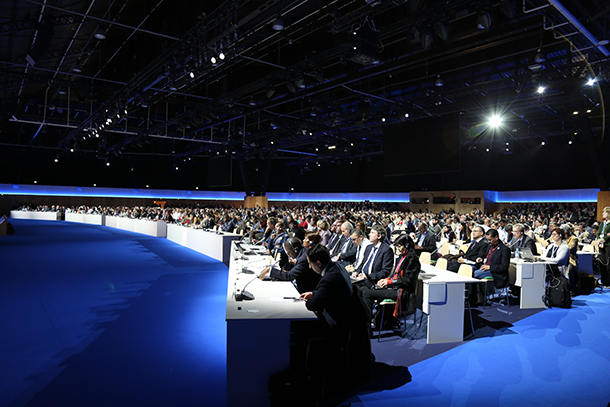
The opening plenary of COP21 (Photo: UNclimatechange, Flickr CC BY 2.0)
CURWOOD: COP21 organizers say some 40,000 people are expected to participate in one way or another over the two weeks of these talks, and more than 180 countries have reported self-determined action commitments for reducing global warming emissions. These are called Intended Nationally Determined Contributions, or INDCs, and they are in sharp contrast to commitments under Kyoto, which mandated a narrow range of reductions for just the developed nations. Joining us now, as talks head into their final week, is Alden Meyer of the Union of Concerned Scientist, a veteran of 20 of the 21 COPs – dating back to 1994.
MEYER: This one is by far the biggest, and I think there's more momentum going into this COP for an agreement than there has been for any of the previous ones. There's certainly more engagement by heads of state, both from developed and developing countries. They were just here on Monday, over 150 leaders from around the world, and it's clear that they all want to see an agreement at the end of next week here in Paris. It remains to be seen how ambitious and comprehensive that agreement is going to be.
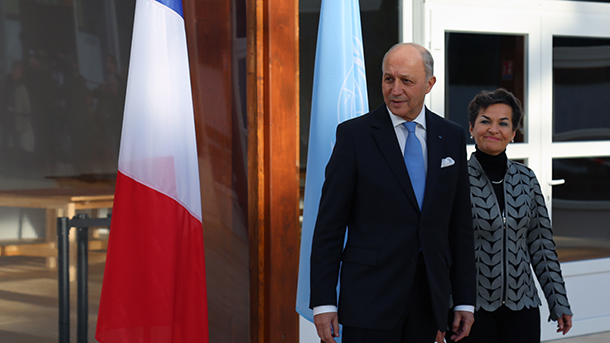
Laurent Fabius, the President of COP21, and Christiana Figueres, Secretary of the UNFCCC (Photo: UNclimatechange, Flickr CC BY 2.0)
CURWOOD: What's motivating more cooperation this time, do you think?
MEYER: Well, I think the impacts of climate change are ever more evident to people around the world, countries are aware of the serious nature of what's coming at us if we don't take greater action. I think also the change in the economics of the solutions is having an impact. The fact that renewable energy prices has come down so dramatically in the last few years is making people realize that they can take ambitious action and have it actually help their economies, not hinder their economic development.
CURWOOD: What's the quality of the agreement you expect to come out of here?
MEYER: Well, we hope to get an agreement that recognizes that we have a gap between the commitments that have been put forward by countries so far, and what we need to do if we're going to have a chance to stay under the two degrees Celsius limit, 3.6 degrees Fahrenheit limit, that President Obama and other leaders agreed to in Copenhagen six years ago. And we need a process that gets countries to return to the table relatively quickly to ramp up the level of ambition of their commitments, certainly no later than the end of this decade. We can't afford to lock into place the current level of ambition out to 2030 and think that we have a chance to avoid the worst impacts of climate change.
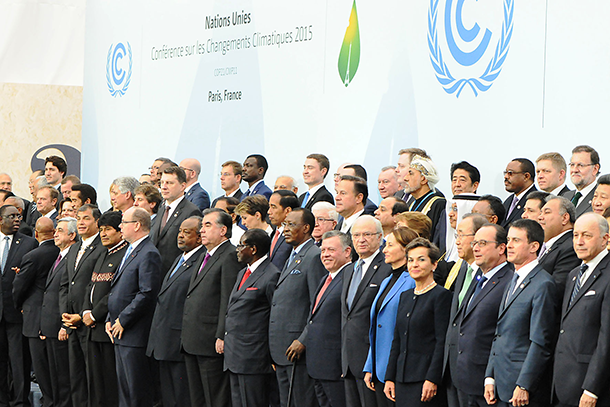
More than 150 world leaders present at the beginning of the Paris climate talks gathered for a photo op. (Photo: UNclimatechange, Flickr CC BY 2.0)
CURWOOD: You mention the two degree target, but speaking from your perspective, from the Union of Concerned Scientists, how safe is that as a limit?
MEYER: We would not use the word "safe". I mean, you can see what is happening around the world now in terms of climate-related impacts at less than one degree Celsius, so the reality is there really is no safe level. I think what you have to look at is sort of two degrees as a defense line, but if we go beyond that we increasingly get into very dangerous territory. And, frankly, scientists are concerned about where are the tipping points, where are the irreversible impacts where you can't turn things around, and the reality is we don't know exactly where those are. So we have to be very cautious about how great an experiment we run with the planet in terms of temperature increase.
CURWOOD: We've been talking about limits for emissions of greenhouse gases. What about the need to have an international agreement that deals with the question of adaptation, updating the agreement?
MEYER: Well, that's the other side of this. There needs to be a recognition, even if we succeed in holding temperature increases under the two degree Celsius goal, that the world is going to experience increasing impacts of climate change in coming decades, just on the basis of the emissions we put into the atmosphere over the last century and a half. We're committed to almost 1.5 degrees warming no matter what we do, if we turned emissions off overnight, which of course we are not going to do, and we're only a little under one degree of warming experience to date. So you can imagine what the future is going to look like in terms of sea level rise, in terms of drought, flooding, other climate impacts and we need strategies in the Paris agreement to ramp up assistance to, particularly, vulnerable developing countries to build their ability to adapt and cope with what's coming at them.
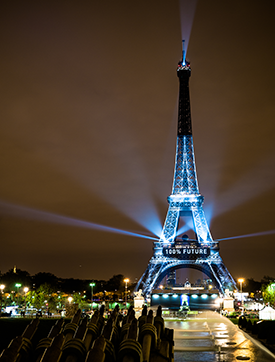
An art installation that illuminated the Eiffel Tower on the eve of the climate talks in Paris called for a shift to 100% renewable energy and the protection of the world’s forests. (Photo: Yann Caradec, Flickr CC BY-SA 2.0)
CURWOOD: Let's talk about where the negotiations are now, headed into this week where the ministers come together to find political solutions. First, what about on the question of limiting emissions, where are the sticking points now? What needs to be resolved?
MEYER: Well, there are several issues there. One is the long-term goal. What is the long-term direction we're trying to set in this agreement of where the world needs to be by mid-century in terms of emissions. That's quite a contentious issue. The science is pretty clear that we need to be well on a pathway to totally decarbonizing the global economy by midcentury if we're going to avoid the worst impacts of climate change. Another issue is how quickly we review the effectiveness of what countries have put on the table. Many of the most vulnerable countries and the nongovernmental groups have been pushing for a review no later than the end of this decade, because it's quite clear that we need to increase activities starting no later than 2020. A third issue is how you provide support for developing countries to unlock the conditional offers they've made to increase the ambition of their efforts if they have access to finance, technology, and other support, so that's being discussed. These are all tough issues but they're all key to getting the ambition package we need in the Paris agreement to deal with the gap.
CURWOOD: What about the sticking points on adaptation, what needs to be settled by these ministers?
MEYER: Well, there's a couple of issues there. One is whether developed countries in particular will commit to increase the share of their public finance support going to adaptation. Right now I think it's less than 20 percent of the total amount of climate finance provided to developing countries is on adaptation. The large share of it is for mitigation activities. So that needs to be ramped up, because, as opposed to investments in clean energy technologies and other mitigation strategies, adaptation is one area where you can't leverage private sector finance to the extent you can on something like renewable energy investments, or cleaning up a power plant, or energy efficiency and buildings. So there needs to be greater public finance. The other issue is helping countries develop the capacity to do adaptation planning and implementation. This is a tricky business that cuts across every sector in the economy, from healthcare to agriculture to coastal impacts, and it really does take well-trained infrastructure and people to deal with what they have to do on adaptation.

The Living on Earth COP21 reporting team, Steve Curwood, Helen Palmer and Emmett FitzGerald.
(Photo: Jennifer Stevens-Curwood)
CURWOOD: The president of China said it's important to have a binding agreement here, a legally binding agreement here. The United States is a little nervous about some of this language, as I understand it, because it's unlikely to ratify any new treaty brought forth by the Obama administration. How does this process thread that needle?
MEYER: Well, there's an understanding that what comes out of here next week will be a legal agreement, it will be under the Framework Convention on Climate Change that was negotiated by the first President Bush and was ratified by the U.S. Senate, so that's the law of the land, and there will be elements of it that will be legally binding. The debate in the negotiations is what are those elements and what's the language. The one that the administration has the most trouble with is one that would say that we are legally bound to achieve the 26 to 28 percent emission reduction below 2005 levels that President Obama committed to by 2025, because under the terms of the ratification agreement of the original Rio treaty with the Senate, their lawyers tell them that would require submitting the entire agreement to the Senate for an up or down vote, and we know there's nowhere near the 67 votes needed to ratify anything on climate change coming out of this meeting.
CURWOOD: Alden Meyer, Director of Strategy and Policy for the Union of Concerned Scientists. Thanks so much for taking the time with us today.
MEYER: Thanks, Steve. I really enjoyed it.
Related links:
- Timeline of key events in UN effort against climate change
- About Intended Nationally Determined Contributions (INDCs)
- INDC submissions from nearly 160 countries
- Plans to adapt to climate change
- Financial backing for plans
- Paris climate summit: the climate circus comes to town
[MUSIC: Jacques Loussier Trio, variations on “Harpsichord Concerto No.3 in D,” J.S. Bach/arr. J. Loussier, The Bach Book: 40th Anniversary Album, (Telarc 1999)]
CURWOOD: Just ahead...climate protection as a human right and the special challenges for coal. Stay tuned to Living on Earth.
[MUSIC: Jacques Loussier Trio, variations on “Harpsichord Concerto No.3 in D,” J.S. Bach/arr. J. Loussier, The Bach Book: 40th Anniversary Album, (Telarc 1999)]
Climate Activists Defy Paris Protest Ban
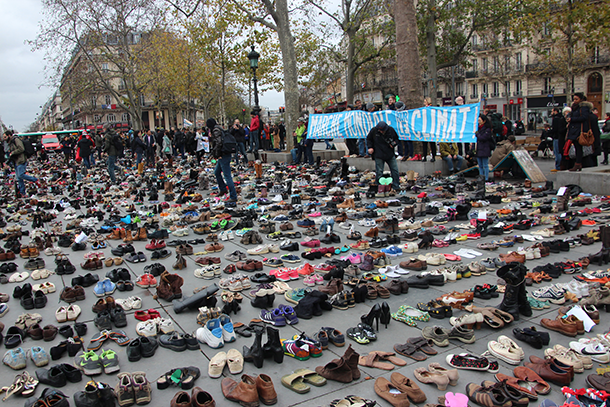
Banned from carrying out a march in Paris, climate activists placed thousands of shoes in the center of the Place de la Republique in symbolic protest. (Photo: Takver, Flickr CC BY-SA 2.0)
CURWOOD: It’s Living on Earth, I'm Steve Curwood in Paris. As the climate summit was getting underway, millions of people around the world rallied in support of action, but the crowds were much smaller here, where the deadly terrorist attacks two weeks earlier prompted a strong show of armed police on the streets and a ban on demonstrations. Many of those who took to the streets in Paris said they see climate justice as a human right, and the economic emphasis of negotiations puts profits ahead of people. Living on Earth’s Emmett Fitzgerald has our story.
FITZGERALD: Here in Paris, indigenous activists marked the day before the climate summit kicked off with a moment of healing outside the Bataclan Theater, where 89 people lost their lives last month.

Nearly 5,000 activists formed a human chain along the route of the cancelled march. (Photo: Joshua Rifkin)
[SINGING]
FITZGERALD: That’s Dallas Goldtooth, an environmental activist from the Indigenous Environmental Network. He says that native people have something unique to offer during tragic times like these.
GOLDTOOTH: As indigenous peoples, we are well aware of tragedy. It’s a part of our experience and so we want to acknowledge that moment in this space right here, and bring our positive energy and to bring a path forward of sorts.
FITZGERALD: The attacks prompted the French government to prohibit all major protests during the UN summit, a decision some climate activists thought was wrong.
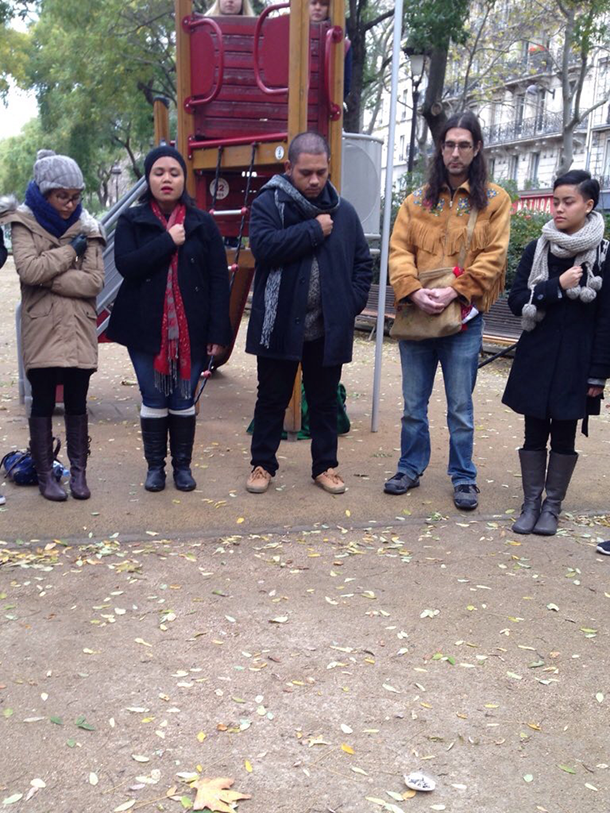
Indigenous activists, including youth from the Marshall Islands, conduct a moment of healing outside the Bataclan Theater. (Photo: Emmett FitzGerald)
WEISNER: I think that the state of France is making a huge error in terms of cancelling the marches.
FITZGERALD: Cindy Weisner is the head of the Grassroots Global Justice Alliance.
WEISNER: We see the hypocrisy of them allowing Christmas markets to continue, allowing football matches to continue. And I think that the response that would have honored the people that were killed, and the proper way to mourn folks, is to be able to say we’re not afraid, we’re here.
FITZGERALD: With the major climate justice march in Paris cancelled, activists turned to symbolic protest. They placed thousands of shoes, including a pair from Pope Francis, in the center of the Place de la Republique to show the breadth of support for strong action on climate change and a commitment to human rights. And nearly 5,000 protesters defied the ban altogether, forming a human chain that stretched through the city along the planned march route—the two mile length of Boulevard Voltaire. Activists from all over the world linked arms, including many young people.
MUDZONGO: My name is Wadzanai Mudzongo and I’m from Zimbabwe. In Zimbabwe we’re experience floods and droughts, which are affecting agriculture, which used to be our breadbasket, so it’s leading to hunger and poverty.
FITZGERALD: Wadzanai says she was disappointed that the march was cancelled, but she’s happy to see so many people in the streets today.
MUDZONGO: It’s quite a good feeling because we are out here in solidarity together. People from around the world, from Africa, from Europe. And we are all here to push one agenda. One goal.
FITZGERALD: And what is that goal?
MUDZONGO: We’re fighting to end climate change and to have climate justice.
[CHANTING - “CLIMATE JUSTICE, PEOPLE POWER”]
FITZGERALD: They’re making it pretty clear what you want.
MUDZONGO: Yeah exactly, people power and climate justice. Exactly! On point.
FITZGERALD: There was a lot of energy on the streets of Paris, but not much excitement about what’s going on inside the negotiating rooms at the UN Summit. Among the groups forming the chain was the Women’s Earth and Climate Action Network. Osprey Orielle Lake is Executive Director, and she says she’s glad that countries are beginning to take climate change seriously, but that the national commitments on the table in Paris don’t go nearly far enough.
ORIELLE: Our scientists are telling us 80 percent of all fossil fuel reserves have to stay in the ground. That’s not on the table in the agreement. We know we need to keep at 1.5 degrees warming of global temperatures. That’s not on the table, the commitments so far don’t even get near that threshold.
FITZGERALD: And that’s a life and death concern for people on the frontlines of climate change. Allison Warden is an artist, activist, and member of the Iñupiaq tribe in the Arctic National Wildlife Refuge in Northern Alaska.
WARDEN: The effects of climate are felt most acutely in the arctic. We are the ones who are paying the price most severely. And see the changes the most.
FITZGERALD: Allison says that to protect the most vulnerable people, negotiators need to ensure that a lot of the world’s fossil fuel reserves never get burned.
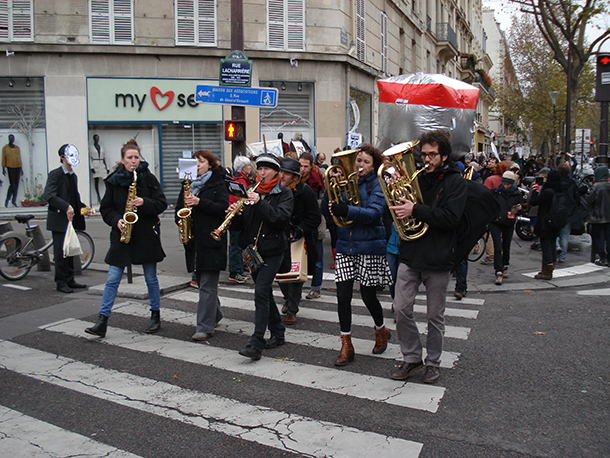
Climate activists marched through the streets of Paris playing brass instruments. (Photo: Joshua Rifkin)
WARDEN: We are in an awkward time in the state of humanity. But also a very exciting one. The fossil fuel era is not sustainable. And I’m saying that as a person who sits on land that has supposedly millions of barrels underneath our land. But I want to keep it in the ground, because we cannot afford to burn that carbon.
FITZGERALD: Cindy Weisner of the Grassroots Global Justice Alliance has been following the climate negotiations for the past 21 years with frustration, not only with the lack of a meaningful deal, but with the type of solutions that are on the table.
WEISNER: And I think that if we’re really looking at resolving the issue of the climate crisis, it’s not going to be based on carbon markets, it has to be very radical in terms of real commitments to reducing mandatory emissions. It’s about keeping oil in the soil, it’s about a transition that’s going to prioritize the people directly impacted, and so those are the kind of things that we’re putting forward.
FITZGERALD: Many of the climate activists in the streets of Paris want to see enforceable commitments on emissions reductions, and they don’t want carbon trading schemes. But Ananda Lee Tan of the Climate Justice Alliance says that’s unlikely, because the people at the negotiating table are beholden to powerful corporate and national interests.
TAN: What I would call the pollution profiteers are at the table, and the voices that are really demanding systems change, rather than climate change, are outside in the streets.
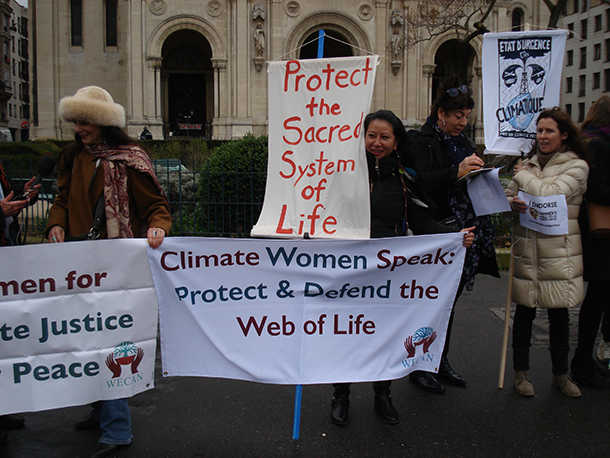
Activists from the Women’s Earth and Climate Action Network hold signs. (Photo: Joshua Rifkin)
FITZGERALD: Ananda says that if we really want to solve the climate crisis, we need to make our entire economy and energy system truly local.
TAN: So rather than turning to Big Ag, we should be turning to small farmers, rather than turning to big landfill and incinerator companies we should be turning to local recyclers and waste workers, rather than turning to massive utility systems we should be looking at community based energy and localized energy systems.
FITZGERALD: And Cindy Weisner agrees that if we want to solve a problem as big as the climate crisis, we need a just transition, not only from fossil fuels to renewable energy, but from corporate power to people power.
WEISNER: A just transition that really begins to build local living economies in communities, where we can begin to talk about energy democracy, zero waste, different solutions that are actually going to cool the planet.
[MUSIC: CLIMATE ENSEMBLE BRASS BAND PLAYING “This Land is Your Land”]
FITZGERALD: The peaceful protest took a turn as hundreds of police in riot gear surrounded a group of more confrontational, anti-capitalist protesters in the Place de la Republique.
[TEAR GAS FIRING]
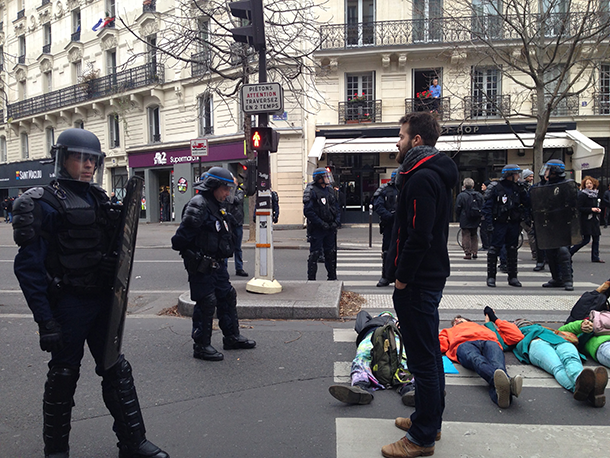
Protesters in a standoff with French police near the Place de la République in Paris (Photo: Emmett FitzGerald)
FITZGERALD: Police fired tear gas canisters into the crowd and soon the square was filled with a noxious haze. Reports have differed about what sparked the change, but a climate activist who would only give her first name, Sheila, says the police response was unwarranted.
SHEILA: It was a march, it was a peaceful march that was going to happen today. People marching for the climate, for the earth, for humanity. These are not bad reasons to march, this is not about people wanting to fight. This is about people wanting to love and to have people love this space that we live in.
FITZGERALD: After the attacks, French police used state of emergency laws to put several climate activists under house arrest. Sheila says it’s all part of an effort to quash opposition to the conference.
SHEILA: It’s not about safety, it’s about not allowing people to stand up for what they believe in, and to speak out against the COP21.
FITZGERALD: To keep global warming beneath two degrees Celsius, Sheila says we need to fundamentally change the economic system, but that’s not a message that authorities in Paris want to hear.
SHEILA: The French government wants this agreement to be the agreement that saved the world. They don’t want the voice of dissent marring that picture. They don’t want people to be standing up and speaking out against that.
[MUSIC: CLIMATE ENSEMBLE BRASS BAND PLAYING “Bella Chao”]
FITZGERALD: The climate justice movement has found ways to make itself heard during the opening week of COP21, and it isn’t about to stop now. For Living on Earth, this is Emmett FitzGerald in Paris.
[MUSIC: CLIMATE ENSEMBLE BRASS BAND PLAYING “Bella Chao”]
Related links:
- Pictures from the international day of action
- Police Clash with Protesters in Paris
- The Powerful Message Behind These Shoes
- Art Installation Lights Up Eiffel Tower on Eve of Paris Climate Talks
- More about climate change and COP21
- Draft Agreement for Paris Climate Negotiators
- Video: Shoe Demonstration
- The big climate march is off in Paris, but still on in a city near you
How Will the World Address Loss and Damage From Climate Disruption?
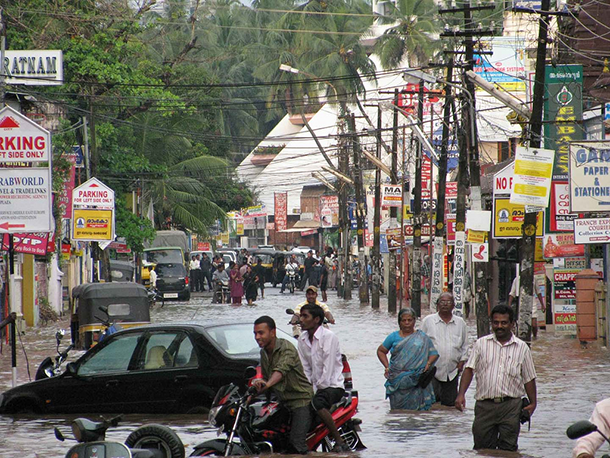
Thampanoor the transport hub of Trivandrum, capital city of Kerala in India during the monsoon season. Climate vulnerable countries like India are looking for loss and damage agreements out of the COP21 talks to help with adaptation and mitigation of climate change effects. (Photo: indiawaterportal.org; Flickr CC BY-NC-SA 2.0)
CURWOOD: Along with mapping a path to a carbon-free future and adapting to the changing climate, a third branch of negotiations has emerged in recent COPs and come to a head here in Paris. It is the question of loss and damage, or what should be done when people are permanently displaced by rising seas or other effects of climate disruption.
Right now those driven out by climate change are not recognized as refugees, and no agency helps sort out what happens when neighborhoods or regions or even whole nations disappear. Erica Bower is the lead loss and damage campaigner with the American youth group SustainUS.
BOWER: Climate displacement is a reality that is here and now. It's not over there in the future. It is something that is on the present, even in countries like United States. The internal displacement monitoring center cites that 26 million people are displaced annually by disasters, and this is the status since 2008, but it's only likely to become increased every single year with climate change impacts. Even in our own backyards in New Jersey, over 39,000 people who were displaced by Hurricane Sandy are without homes over three years after the disaster, and in particular these are portions of the population that are marginalized already — lowest socioeconomic status as well as communities of color — and climate change and climate displacement serves to exacerbate those pre-existing qualities.
CURWOOD: Who should pay for climate displacement?
BOWER: First, nation states, but when it is not possible for a country to cover their own nations’ disaster displacement, that is when the international community should step in. That is when the Warsaw mechanism on loss and damage should include a climate displacement coordination facility that would enable the international committee to support those populations.
CURWOOD: In New Jersey, almost 40,000 people homeless as a result of what happened with superstorm Sandy, who should pay for them to get them homes?
BOWER: I believe that it is the responsibility of United States government to protect those populations and to make sure they are resettled. FEMA has undertaken some response, however the funding is disproportionally allocated to the populations that are already the wealthiest, and the populations that are most vulnerable are the ones who remain displaced and homeless.
CURWOOD: So, there are a number of small island states, places from Kiribati, Mauritius, all these places close to sea level soon to be under the sea. Who should pay?
BOWER: I believe that the international community including the states present at the UNFCCC should provide compensation and what they're calling now "innovative finance". The word “compensation” is a huge no-no at the moment in terms of its polarizing effect on negotiations. Innovative finance and insurance mechanisms to ensure that these countries are able to return to homes is one option. Loss and damage mechanism also includes the need for technical support, for instance, early warning systems, disaster risk reduction measures. This kind of climate displacement coordination facility that I mentioned earlier, which could serve as a storing house for best practices and enable countries to learn how to respond to these challenges.
CURWOOD: So, just to be clear, you're not talking about loss and damage totaling up what some rich country like the United States has done in terms of carbon pollution and saying they have to pay compensation for this pollution to these people.
BOWER: No, I believe loss and damage is about more than just that. I believe that it has evolved over the course of these negotiations and has take on a character of its own, and now loss and damage includes the need for technical support.
CURWOOD: It sounds like it does include this notion that certain nations did some polluting which caused damage to others.
BOWER: So the polluter pays principle, which I believe you're referencing, is certainly an intrinsic part of what loss and damage is in the UNFCCC context. Nations like United States have a responsibility because of historic commissions to compensate the countries that are most vulnerable to climate change. I don't believe it's politically palatable at the moment.
CURWOOD: What are your hopes for what can actually come out of these negotiations?
BOWER: At the very minimum, I hope that there is a loss and damage mechanism that is an article of the UNFCCC final decision text. It is particularly crucial for this climate displacement to be recognized in this text, because this text sets the agenda for the next 50 years. And if this issue has a hook in the text now, that means that funding as well as program support and technical support will come in the years ahead.
CURWOOD: If not now.
BOWER: If not now. Also, as a young person — and SustainUS is a youth organization — I believe that loss and damage is an issue that we are inheriting, it is our future and it is vital that this text recognize generational inequity and the needs of future generations, and in order to do that they need to have a strong mechanism of loss and damage, that begins today.
CURWOOD: Erica Bower with SustainUS. Thanks so much for taking this time with me today.
BOWER: Thank you so much.
Related links:
- SustainUS
- COP21 edges towards loss and damage deal
- Why COP21 Won't Solve the 'Climate Refugee' Problem
- At COP21, a Frantic Debate Over Climate Aid, and Some Hopeful News About Climate Insurance
- UNHCR: the UN Refugee Agency on climate change and refugees
- Podcast: Why is loss and damage a hot issue at COP21?
- Legal limbo awaits millions of future ‘climate refugees’
- How Climate Change is Behind the Surge of Migrants to Europe
- What Happens When Your Country Drowns?
- Film on Climate Refugees Strikes a Chord
- India Says UN COP20 Fails Poor Countries
- What is the 'polluter pays' principle?
2400 Coal-Fired Power Plants Planned Despite Climate-Friendly Pledges
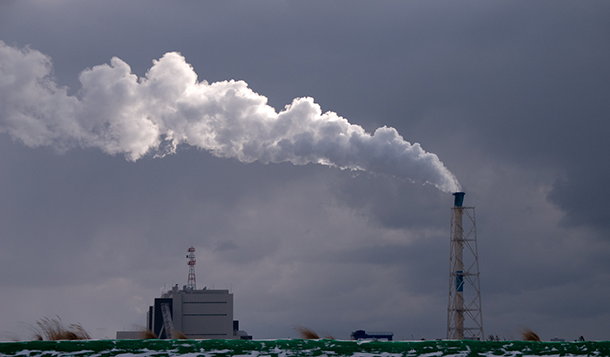
Japanese coal plant (Photo: Chris Lewis, Flickr CC BY-NC 2.0)
CURWOOD: Fossil fuels are in the crosshairs of any agreement reached here in Paris, and none more so than coal because of its high levels of global warming and local pollution. And though just about every nation has made carbon-cutting pledges, many new coal-fired power plants are in the planning stage. A new analysis just released at the climate summit details exactly how inconsistent these plans are – it comes from Germany’s New Climate Institute, that tracks power plant emissions. Living on Earth’s Helen Palmer spoke with the author Niklas Höhne to find out the details.
PALMER: Niklas Höhne, tell me briefly what you found.
HÖENE: We looked at datasets that say how many coal-fired plants are currently being planned and currently being built, and checked whether the emissions that would come from these coal-fired plants, how they relate to what is necessary to keep climate change under control to meet the internationally agreed goal of not more climate change than two degrees. We find that more than 2,400 coal-fired plants are in the pipeline globally, and that is in a stark contrast to what would need to happen to keep temperature rise below two degrees. We looked at all the scenarios that try to reach this goal of two degrees, and they consistently find that the electricity sector globally has to reduce its emissions to zero by 2050, and that basically means global phaseout of emissions from coal-fired plants by the middle of the century. That's in 35 years. An average lifetime of a coal-fired power plant in 40 years, so anything that's built today will still be running by the middle of the century. If we are serious about the two degree goal, no single coal-fired power plant should be built today.
PALMER: How does that relate to global emissions and to other emitting factors?
HÖENE: So global emissions today are around 50 gigatonnes. The US emits in total around five gigatonnes. In order to be on the pathway towards two degrees, global emissions have to go down from 50 to around 42 gigatonnes in 2030. And if you just calculate all of the emissions from existing and these newly built power plants, you get together 12 gigatonnes. So, one third of the allowed emissions in 2030 will come only from coal-fired power plants, and that would mean no room for any other emissions — transport, buildings, agriculture and so on.
PALMER: If by any chance they were built, what would that mean the global temperature would go up by?
HÖENE: We calculated if all countries would do what they have already proposed in their national plans, we would go up to a temperature increase of 3.6 degrees, but adding all of these coal-fired power plants, it would even be above that, so we would more go in a direction of four degrees than two degrees which is the agreed goal.
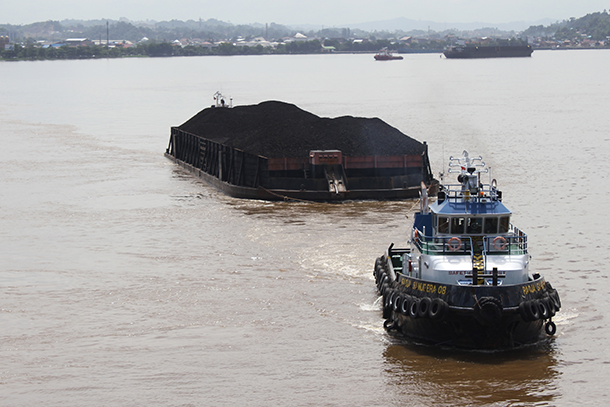
Indonesian coal barge (Photo: Andrew Taylor/WDM, Flickr CC BY 2.0)
PALMER: So these are obviously numbers that doesn't add up.
HÖENE: [LAUGHS] Exactly, so the conclusion from all of this is that governments should be active right now to review their plans of building coal-fired power plants.
PALMER: So, which countries are planning to build all these power plants?
HÖENE: Quite a lot of countries are building coal-fired plants. China is leading. China is very big and has a lot of demand for new electricity, so that's why it has plans for new coal-fired power plants. Second largest is India. But then come a few other countries like Turkey, like Japan, and then a little bit later comes the US, where also 3.5 gigawatts of coal capacity are planned.
PALMER: Well, obviously, countries like India and to a limited extent China are still developing. I mean, India's argument is that they need these power plants, because they need, basically, to bring power to their people.
HÖENE: That is very very valid argument, and understandable from the Indian point of view. India’s per capita emissions are a fraction of those European or even smaller compared to the US per capita emissions. But, having the global view, also in India there should not be a future power plants, so the element is here at the international negotiations that the other countries help India to develop in a way that is less emission intensive, help them with the technology for renewable energy, help them with energy efficiency, help them with better electricity grids, so that the electricity from existing coal-fired power plants can move to the other areas where there's no electricity.
PALMER: What do you put it down to, that there is this disconnect between what they say they’re going to do and what they plan for their power?
HÖENE: Not everybody has a global view. There may be investors that see there's a demand for electricity, and the cheapest way to get it is a coal-fired power plant. For them, the time horizon is not 40 years, for them the time horizon is the payback period and that may be much much quicker. So for them, economically, it may still be viable to build that coal-fired power plant, but for the society as a whole, the country India or the global society, it does not make sense. And that's something that needs to be solved when it comes to climate change. Why this is so severe today is that renewable energy right now has changed dramatically in the past years, and has now become much, much cheaper, and predictions for renewable energy are much, much higher than we thought five or ten years ago. And that's inconsistent with the long time horizons for coal-fired powered plants.
CURWOOD: Niklas Höhne of the New Climate Institute spoke with Living on Earth’s Helen Palmer.
Related links:
- Coal plant plans could wipe out hope of holding warming below 2°C, and threaten achievement of INDCs
- Faster and Cleaner – Decarbonisation in the power and transport sectors is surpassing predictions and offering hope for limiting warming
- Japan, US and other OECD members agree to cut financing for overseas coal power plants
- UK to Shut Down All Coal Power Plants by 2025, But Will Remain Fossil Fuel Dependent
- More New Coal Fired Projects News
- China defends coal use ahead of Paris climate summit
- New Climate Institute
- India's coal addiction
[MUSIC: Stephane Grappelli et al, “As Time Goes By,” Herman Hupfeld on Cinema: A Windham Hill Collection (Windham Hill Records 2005)]
CURWOOD: Your comments on our program are always welcome. Call our listener line anytime at 800-218-9988. That's 800-218-99-88. Our e-mail address is comments@LOE.org. That's comments@LOE.org. And visit our webpage at LOE.org. That's LOE.org.
[MUSIC CONTINUES]
Coming up...the sun is rising and bringing a new energy dawn to the world’s largest democracy. That's just ahead here on Living on Earth. Stay tuned.
ANNOUNCER: Funding for Living on Earth comes from United Technologies, a provider to the aerospace and building systems industries worldwide. UTC Building & Industrial Systems, provide building technologies and supplies container refrigeration systems that transport and preserve food and medicine with brands such as Otis, Carrier, Chubb, Edwards and Kidde. This is PRI, Public Radio International.
[CUTAWAY MUSIC: La Planche a Dixie, “On the Sunny Side Of the Street,” Jimmy McHugh/Dorothy Fields, recorded by Helen Palmer on the Boulevard Saint Germain, outside Eglise de Saint-Germain-des-Pres, November 2015. (Not commercially available)]
India's Solar Initiative and the Challenge of Climate-Safe Development
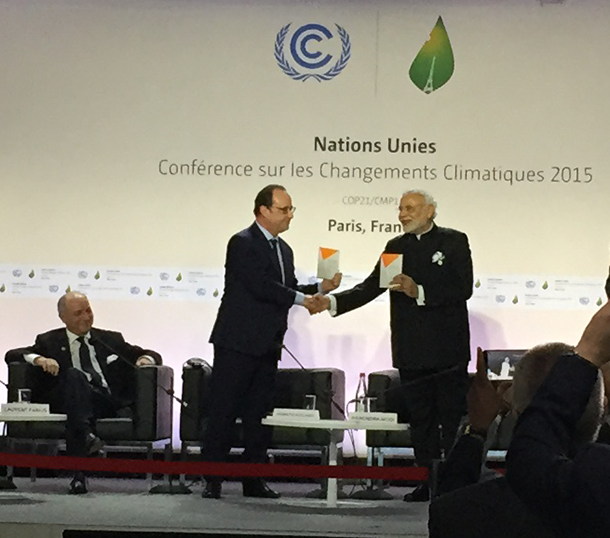
Prime Minister Narendra Modi and President Hollande onstage at the session. (Photo: Jennifer Stevens)
CURWOOD: It's Living on Earth, I'm Steve Curwood at the climate summit.
[INDIAN MUSIC]
CURWOOD: The Prime Minister of India, Narendra Modi, partnering with COP21 president Francois Hollande and UN Secretary General Ban Ki-Moon, have just launched the international solar alliance. One hundred and twenty nations around the world will cooperate to, as Mr. Modi put it, “meet [the] energy needs of member countries in a safe, convenient, affordable, equitable and sustainable manner.” A key goal of the initiative is to mobilize a trillion dollars by 2030 to solarize the developing world, according to India’s prime minister.
[MUSIC]
MODI: Today, the world must turn to sun to power our future. As the developing world lifts billions of people into prosperity, our hope for a sustainable planet rests on a bold global initiative. It will mean advanced countries leaving enough carbon space for developing countries to grow. That is natural climate justice. The vast majority of humanity is blessed with generous sunlight round the year. Yet many are also without any source of power. This is why this alliance is so important. We want to bring solar energy into our lives and homes by making it cheaper, more reliable, and easier to connect to grid.
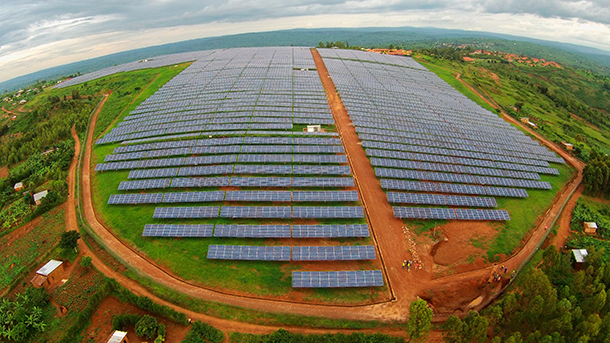
A solar field in Rwanda (Photo: IIP Photo Archive, Flickr CC BY-NC 2.0)
CURWOOD: The alliance will develop best practices and common regulation, stimulate investment and solar product development, Modi said, and will become the foundation of the new economy.
MODI: This is an alliance that brings together developed and developing countries; governments and industries; laboratories and institutions, in a common enterprise. This day is the sunrise of new hope — not just for clean energy, but for villages and homes still in darkness, and for more mornings and evenings filled with the clear view of the glory of the sun. Thank you very much.
[APPLAUSE]
CURWOOD: As Prime Minister Modi spoke, many leaders from around the world listened attentively. A number from Africa sat in the front row, and some told me that they welcome this initiative and think India’s size and scale can drive the developing world’s solar revolution.
DESALEGN: My name is Hailemariam Desalegn, I’m Prime Minister of Ethiopia.
CURWOOD: How important is solar energy for Ethiopia?
DESALEGN: It is so important because it is renewable energy. The intensity of solar power energy is so huge that we can generate more power, and we can also reduce greenhouse gas emissions to the atmosphere, which creates problems now. We have extreme storms, heavy floods, extreme droughts taking place in many places on the globe, especially in Ethiopia as well, so it is very very important for us.
CURWOOD: How much money will it take to get solar on a big scale in Ethiopia, do you think?
DESALEGN: We have some projects now we're working on. I think the cost of solar energy is now reducing because the technology is improving very much, but still it's a little [more] expensive than hydro, wind, and geothermal energy, but if the pace of technology improvement goes on this way we can get much better.
CURWOOD: Thank you very much for taking this time. Briefly, how do you feel about the negotiations? How are they going?
DESALEGN: The positions are better than the usual other COPs, but still we need to move very fast because Africa needs to reduce 1.5 degrees Centigrade temperature, compared with preindustrial revolution. This is very important. If we go even to two degrees Centigrade Africa will suffer, so I think we need to push very much the global community, especially the developed nations has to be very supportive in this regard.
KENYATTA: My name is Uhuru Kenyatta, President of Kenya.
CURWOOD: How important is solar for the development of Kenya?
KENYATTA: Well, solar is indeed important because we have an abundance of it and that's why we are keen to participate together under this initiative to see how we can exploit that potential that we have. But the costs in the past have generally been very prohibitive, and we're very keen to therefore see how we can work with others both on accessing cheaper finance but also in tapping better technologies, cheaper technologies. Kenya has already made large investments in this particular sector, we now have about 100 or 150 megawatts of solar energy already connected to our grid. We're looking to expand my going forward. We have a couple of projects ranging from about 50 megawatts in different parts of the country and we're very keen to exploit this renewable source of energy which we have plenty to help us achieve our social, economic objectives.
CURWOOD: Tell me how you would use solar in Kenya. You have big cities, you have nomadic tribes people, it's such a diverse country. How would you best use solar, do you think?
KENYATTA: Well, solar would be the best mechanism to use, especially in areas that are off-grid, because the resource is there. So we think that therefore it's something that we should really take advantage of. It's something that you can tap and you don't really need the grid to get it to the people because the resource is where the people are.
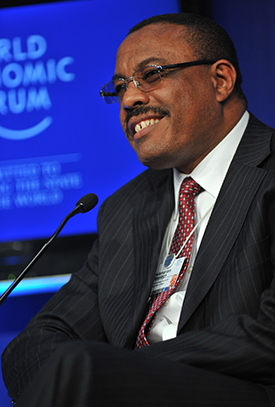
Hailemariam Desalegn is the Prime Minister of Ethiopia. (Photo: Eric Miller/World Economic Forum, Wikimedia Commons CC)
CURWOOD: At the Copenhagen meeting I had a chat with Wangari Maathai, who is sadly missed, A, and, B, really determined of course to plant as many trees as possible. What do you think Wangari Maathai would say today about the solar initiative?
KENYATTA: I think she would be very keen. I mean, if there is a way to really save our environment, to stop our people from cutting forests in order to access firewood and other means of cooking energy and be able to use solar instead, it would go a long way towards achieving her dream of protecting our environment, protecting our forests. I think she would be a great supporter.
CURWOOD: And how do you feel about these negotiations? How are they going?
KENYATTA: Well, like I'm saying what we want is something that's legally binding and people to make commitments and to fulfill their obligations, and we're hoping that especially the big, the developing countries are going to be able to work with us in the developing world, make clear commitments. We need to be able to achieve the sustainable development goals that we accepted as an international community in New York in September of this year. We need that support, and we are also equally the biggest victims and yet we are the least contributions of emissions and other problems that affect our environment. So, our hope is that we can get legally binding commitments and a clear platform that is monitorable, manageable; and clear ways in which they are going to help provide the necessary resources that would allow especially the developing countries to achieve their developmental objectives.
CURWOOD: For some perspective on how the India-led solar initiative, as well as the COP21 negotiations, are seen back in India I caught up with Chandra Bhushan, Deputy Director General of the Center for Science and the Environment based in New Delhi.
BHUSHAN: Solar is going to be very important for India, and I think Prime Minister Modi understands this. But he also understands that you need a global coalition to bring down the cost of solar and improve technology, because the current solar technologies is not a replacement for fossil fuels. We're still some time away from solar which will provide energy 24/7, and we will see the result of this coalition, this alliance, in the coming years.
CURWOOD: What about the plans to massively expand coal-fired power plants in India?
BHUSHAN: I think this entire issue has been blown out of proportion. India actually on a per capita basis uses coal which is one fourth of the US. US consumes about 800 million tons of coal compared to 600 million tons from India. And compared to close to more than two billion tons for China. So this entire coal issue that is talked about is blown out of proportion, considering the population and energy need of India. The second point is we are reaching a point on our energy journey where solar is becoming more and more affordable. For six hours today, solar is as cheap as coal. Now we have to convert that six hours into 24 hours. That's where storage will become important and our analysis at the Center for Science and Environment shows that is just a matter of time, maybe in the next 10 years, when solar storage will be as competitive as coal, and India doesn't need to build coal-based power plants. The third issue is, India doesn't have gas, which US has or Europe has, or Europe can get from Russia. A lot of developed countries have moved from coal to gas. That option is not available to us because of water issues, because of high-density of population. The government has taken a position that we're not going to go for shale gas, so we don't have gas. Therefore, the option for India is coal, which I believe is for the short-term. You will see India's coal consumption going down over a period of 15 [years], we will have started reducing, and renewables we will keep increasing. India is worried about coal itself because of local pollution issues, but if the world really wants to solve climate exchange it is not about anti-coal, it should be about anti-fossil fuel. You don't want to see a world where coal is replaced with gas. It's going to be equally disastrous for climate exchange.
CURWOOD: Some are pointing the finger at India as being obstructionist in these negotiations. Your views?
BHUSHAN: I think India is not obstructionist. I think India has a principled approach to climate change which can at times look obstructionist, but I very strongly believe that if you don't have a principled approach to a global common problem then you will not have universal, as well as ambitious, participation. So, for example, the principle of equity and common but differentiated responsibility, which is now been viewed as obstruction by many developed countries, I believe is the bedrock off today and future climate agreement. You need to have common but differentiated responsibility so that people feel that these climate agreements are fair. If you have common but differentiated responsibilities, everyone feels that what they are being asked to do is fair and reasonable, you will have more people participating in it, you will have more enthusiasm in solving climate change. I was very glad to hear President Obama in his speech on Monday essentially saying that US accepts responsibility for causing climate change and he is willing to work on it. I think that is more than enough. I don't think India or any other country is looking for some sort of reparations from the US, we aren't looking for some historical guilt to be atoned, that's not the idea. The idea is that as a leader of the world, the largest economy in the world, we have a lot of hopes from the US. We believed that if US strong on climate change, it will drive the global agenda on climate change. The US approach right now is that we will have bottom up, do whatever you like approach, that approach is not going to keep temperatures below two degrees. We know the irony is that this is not adding up, that we are on path to 3.5 degrees temperature rise, and therefore we need to sit back and analyze whether this bottom up self-regulatory approach is going to work or not. Unfortunately it will not. And that principle-based approach is important and I encouraged my country and other developing countries to make sure we have a principle-based approach to these negotiations.
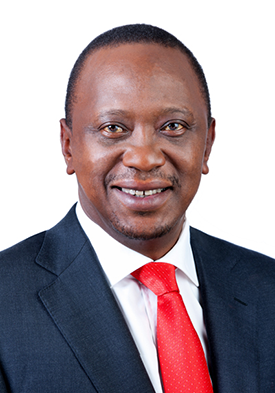
Kenyan President Uhuru Kenyatta (Photo: Nairobi123/Government of Kenya, Wikimedia Commons CC)
CURWOOD: From your perspective, how is India doing in these negotiations?
BHUSHAN: I think India is in a very challenging position right now because on the one hand, we have a large number of poor people who are getting affected by climate change. So we have a huge concern on climate change, but we also have high aspirations. We have 60 percent of our population or more which is below the age of 35. Young people who need jobs are aspiring like any other country in the world, they are looking for jobs and they are looking for basic comforts, which I think should be the fundamental right of everyone. So India actually has to balance its climate position between concerns of climate change and aspirations of its people. So India is in a challenging position, but I also believe there is a concerted effort to actually show India in a poor light. I thought it was very unfortunate for Secretary of State John Kerry to say India is a challenge for climate change, a statement he made about two weeks back. I believe that the western media also is unfairly targeting India without understanding their concerns. It's very easy to say that India is the third largest polluter in the world, the fourth largest polluter. On a per capita basis we will be 134th in the world. So I believe that there are some unfair comments being made about India which is not helpful for negotiations. I believe that countries need to take each other's concerns into account and be polite about it, and then we can have a better outcome. In the current situation where it is almost like a blame game happening, I find the road ahead a little difficult.
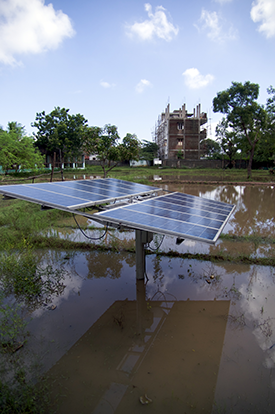
Solar panels power a farm’s water pumps, lights, and more in Tamil Nadu, India. (Photo: PWRDF, Flickr CC BY 2.0)
CURWOOD: Overall, how do you feel these negotiations are going, stepping back and looking at the whole process, how does it feel to you here?
BHUSHAN: You know, negotiations right now are not exciting, there are no great ideas on the table. We are going back and forth on issues which I believe we should have resolved a year back. So I'm not very optimistic of a great deal coming out of Paris, but I'm also not pessimistic that we will not have a deal. We will have a deal, maybe will have a weak deal, maybe we will have a deal which allows us to fight another day.
CURWOOD: I want to thank you for taking time with me today. Chandra Bhushan is Deputy Director General of the Center for Science and the Environment in India.
BHUSHAN: Thank you. Thank you very much. Nice to talk to you.
Related links:
- Working Paper On International Solar Alliance (ISA)
- The International Solar Energy Alliance
- India unveils global solar alliance of 120 countries at Paris climate summit
- Center for Science and the Environment
- Read more analysis from Chandra Bhushand about India's role in the climate talks
- Video of Modi's speech to the COP21
[MUSIC: Chief Stephen Osita Osadebe and his Nigerian Soundmakers, “Onu ‘Wa,” on Sound Time, IndigeDisc/PDSE Records]
CURWOOD: Living on Earth is produced by the World Media Foundation and brought to you with support from the University of Massachusetts Boston, in association with its School for the Environment, developing the next generation of environmental leaders. Our crew includes Naomi Arenberg, Bobby Bascomb, Emmett Fitzgerald, Lauren Hinkel, Helen Palmer, Adelaide Chen, Jenni Doering, John Duff, Amber Rodriguez, and Jennifer Marquis. Jake Rego engineered our show, with help from Noel Flatt. Alison Lirish Dean composed our themes. You can find us anytime at LOE.org - and like us, please, on our Facebook page - it’s PRI’s Living on Earth. And we tweet from @LivingOnEarth. I'm Steve Curwood. Thanks for listening.
ANNOUNCER1: Funding for Living On Earth comes from the Grantham Foundation for the protection of the environment, supporting strategic communications and collaboration in solving the world’s most pressing environmental problems. Support also comes from Trinity University Press, publisher of Moral Ground; Ethical Action for a Planet in Peril, 80 visionaries who agree with Pope Francis, climate change is a moral issue for each of us. TU Press.org, and Gilman Ordway for coverage of conservation and environmental change. Living on Earth is also supported by Stonyfield Farm, makers of organic yogurt, smoothies and more. www.stonyfield.com.
ANNOUNCER2: PRI. Public Radio International
Living on Earth wants to hear from you!
Living on Earth
62 Calef Highway, Suite 212
Lee, NH 03861
Telephone: 617-287-4121
E-mail: comments@loe.org
Newsletter [Click here]
Donate to Living on Earth!
Living on Earth is an independent media program and relies entirely on contributions from listeners and institutions supporting public service. Please donate now to preserve an independent environmental voice.
NewsletterLiving on Earth offers a weekly delivery of the show's rundown to your mailbox. Sign up for our newsletter today!
 Sailors For The Sea: Be the change you want to sea.
Sailors For The Sea: Be the change you want to sea.
 The Grantham Foundation for the Protection of the Environment: Committed to protecting and improving the health of the global environment.
The Grantham Foundation for the Protection of the Environment: Committed to protecting and improving the health of the global environment.
 Contribute to Living on Earth and receive, as our gift to you, an archival print of one of Mark Seth Lender's extraordinary wildlife photographs. Follow the link to see Mark's current collection of photographs.
Contribute to Living on Earth and receive, as our gift to you, an archival print of one of Mark Seth Lender's extraordinary wildlife photographs. Follow the link to see Mark's current collection of photographs.
 Buy a signed copy of Mark Seth Lender's book Smeagull the Seagull & support Living on Earth
Buy a signed copy of Mark Seth Lender's book Smeagull the Seagull & support Living on Earth

